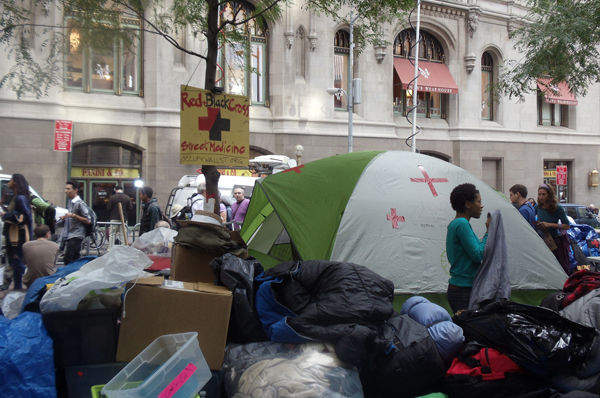
Photo by: Vanesa Vennard
Medical care personnel are working on plans to encourage protesters to find their own winter clothes, sleeping bags and blankets. They’re also banking on receiving more donations.
A cardboard sign that reads “Red + Black Cross Street Medicine” identifies the medical center at the Occupy Wall Street encampment in Zuccotti Park. Medical supplies, volunteers, including registered nurses, and protesters were sheltered there under black and blue tarps on a rainy and cool October morning. But as colder weather approaches, the protesters will need more than tarps to stay warm and well.
“We’re going to need sleeping bags. It’s mostly things like that, wool socks, long johns,” said Josh Lucy, a volunteer at the medical center. He was wearing a grey hat decorated with a red-taped version of the Red Cross symbol, which is how the medical care personnel distinguish themselves from their fellow protesters.
Lucy, 25, works as a senior systems administrator in Miami and took time off to participate in the protest. Originally from Wyoming, he’s familiar with harsh winter weather and came prepared with warm clothes. He said medical care personnel are working on plans to encourage other protesters to find their own winter clothes, sleeping bags and blankets. They’re also banking on receiving more donations.
“There’s X amount in petty cash that people can use,” Lucy said. “Some people are going to try to come up with their own.”
So far, rain has been the big weather problem. A recent October downpour caused protesters to run in search of umbrellas and ponchos and to try to cover their belongings with available tarps. There are trash bags full of already soaked sleeping bags and blankets from previous rainy days.
“It’s tough because of the wet weather,” said Priscilla Gonzalez, 22, who said she has been a part of the protest since the first day. “We have wet sleeping bags they can’t use anymore.”
Gonzalez said they have thought about trying to dry the sleeping bags and blankets at a Laundromat but they haven’t come to a final decision yet. In the meantime, the dry donated sleeping bags and blankets are stored in large plastic bins.
When asked about preparing for the upcoming winter, Gonzalez put her hands on her face to show her distress. “It’s been blowing my mind thinking about it,” she said.
The article of clothing now deemed most valuable are socks, since trench foot and athlete’s foot are main problems. One older man was sitting with his feet elevated on a plastic lawn chair as medical volunteer Wayne Parker rubbed ointment on them. Parker, 32, is a firefighter from Seattle.
The protesters “aren’t getting as many fresh socks,” Parker said. “There’s not an unlimited supply so people are trying to tough it out.”
There have already been at least seven cases of hypothermia, according to New Jersey firefighter Chris Carter, another medical volunteer who said he has been at the protest since Day One. He said they’ve been treating the cases with heating blankets and even by putting cayenne pepper in protesters’ shoes to keep them warm.
“They have to have socks on or it will burn their feet,” he said.
Upstate New York resident Red Grybauskas, 20, organizes the supplies and personnel at the medical center. He thinks that Mayor Bloomberg is counting on the weather to help end the protests. “He can’t really kick us out so he’s letting winter do the job,” he said with a sarcastic laugh.
In the meantime, the protesters are pushing through the rainy days and don’t seem likely to give up easily. Lucy said that he hopes many protesters will be able to withstand the winter with the help of the winter supplies they plan on getting. Meanwhile, he said, “determination is not in short supply here.”
City Limits is grateful to the City University of New York’s Graduate School of Journalism and Professor Lisa Armstrong, who oversaw this project.








